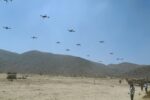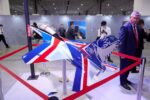The United States Army has deployed a contingent of M2A3 Bradley Infantry Fighting Vehicles (IFVs) to Poland as part of an ongoing effort to reinforce NATO’s eastern flank amid heightened tensions with Russia. The deployment is part of a regular rotational presence under Operation Atlantic Resolve and reflects the Pentagon’s commitment to rapid force projection and deterrence in Eastern Europe.
Strategic Context: Reinforcing NATO’s Eastern Flank
The arrival of M2A3 Bradleys in Poland aligns with broader U.S. and NATO efforts to deter Russian aggression following its full-scale invasion of Ukraine in 2022. The deployment is part of the U.S. Army’s Regionally Aligned Readiness and Modernization Model (ReARMM), which rotates armored brigade combat teams (ABCTs) through Europe on a nine-month cycle.
These deployments ensure that U.S. forces remain forward-positioned for rapid response while maintaining readiness and modernizing equipment back home. The current rotation involves elements from the 1st Infantry Division out of Fort Riley, Kansas—specifically the 2nd Armored Brigade Combat Team (2ABCT)—which replaced the outgoing 3rd ABCT from the 4th Infantry Division.
According to U.S. European Command (EUCOM), these rotations provide “a persistent presence” that enhances interoperability with allied forces while demonstrating resolve against potential adversaries.
M2A3 Bradley Capabilities and Role
The M2A3 Bradley is an upgraded variant of the original M2 IFV platform introduced in the early 1980s. Designed for mechanized infantry support, it combines mobility, firepower, and protection suitable for high-intensity conflict scenarios such as those envisioned along NATO’s eastern frontier.
Key features of the M2A3 include:
- 25 mm M242 Bushmaster chain gun with dual-feed capability
- TOW anti-tank missile launcher (upgraded fire control system)
- 7.62 mm coaxial machine gun
- Improved armor protection including reactive armor tiles
- Enhanced situational awareness via Commander’s Independent Viewer (CIV) and thermal sights
- Digital architecture enabling integration with Blue Force Tracker and FBCB2 systems
The A3 variant also incorporates embedded diagnostics and improved survivability measures such as spall liners and upgraded fire suppression systems. These enhancements make it more effective in combined arms operations alongside Abrams tanks and Paladin howitzers within an ABCT structure.
Deployment Footprint in Poland
The Bradleys have been deployed primarily to Polish training areas such as Drawsko Pomorskie Training Area (DPTA), Żagań, and Bemowo Piskie—locations that have hosted numerous joint exercises under Atlantic Resolve since its inception in 2014.
This latest deployment includes not only IFVs but also supporting logistics vehicles, maintenance detachments, command elements, and artillery units operating self-propelled howitzers like the M109A6 Paladin. Together they form a cohesive combat team capable of conducting live-fire exercises, joint maneuver drills with Polish Land Forces (Wojska Lądowe), and readiness validation events under NATO standards.
The presence also supports multinational battlegroups under NATO’s Enhanced Forward Presence (eFP) initiative—though distinct from eFP proper—by reinforcing regional defense posture through bilateral cooperation mechanisms between Warsaw and Washington.
Operational Implications for Rapid Response
The deployment underscores Washington’s emphasis on rapid force projection capabilities across Europe using prepositioned stocks (APS-2), strategic airlift assets like C-17 Globemasters, sealift via Roll-on/Roll-off ships through ports like Gdańsk or Bremerhaven, and rail mobility within EU infrastructure corridors.
Maneuver elements equipped with Bradleys can be rapidly integrated into regional contingencies ranging from deterrence patrols near Suwałki Gap to defensive operations along potential avenues of approach from Kaliningrad or Belarusian territory. Their presence also facilitates faster mobilization during large-scale exercises such as DEFENDER-Europe or Anakonda drills hosted by Poland.
Modernization Trajectory Beyond A3 Variant
While capable today, the M2A3 platform is nearing obsolescence amid evolving threats including loitering munitions, top-attack ATGMs like Javelin or Kornet-D1 variants used by Russian forces in Ukraine, and drone-guided artillery strikes. As such, this deployment may be among the last major rotations featuring A3 variants before transition toward next-generation platforms begins in earnest.
The U.S. Army’s Optionally Manned Fighting Vehicle (OMFV) program—intended to replace Bradleys starting around FY2029—is progressing through its detailed design phase with competitors including General Dynamics Land Systems’ Griffin III concept. Until then, incremental upgrades such as active protection systems (APS), improved powertrains, or electronic warfare countermeasures may be fielded on existing A3 hulls during depot-level refits at Anniston Army Depot or Red River facilities.
NATO Interoperability Benefits
A key benefit of these rotations lies in enhancing interoperability between U.S., Polish, Baltic State forces—and increasingly Scandinavian partners following Finland’s accession to NATO—with standardized communication protocols like Link-16 integration into ground platforms becoming more common across alliance members’ C4ISR networks.
Maneuver training involving dismounted infantry tactics supported by mechanized platforms helps refine TTPs for joint fires coordination using JTAC teams embedded within ABCT formations—a critical skillset given Russia’s demonstrated use of massed fires integrated with UAV reconnaissance assets in Ukraine since early 2023.
Conclusion: Strategic Signaling Amid Regional Tensions
This latest deployment sends a clear message about U.S. commitment to collective defense under Article V obligations while providing tangible deterrence against further escalation along NATO’s northeastern periphery. With continued investments into armored mobility solutions—including prepositioning initiatives like APS-Poland—the alliance remains poised for high-readiness response even amid contested logistics environments or degraded communications scenarios envisioned in peer conflict models.









